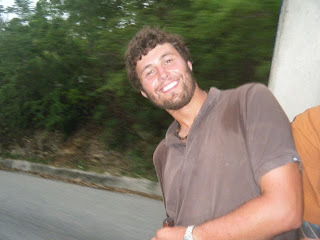I'm finishing writing my thoughts on what 30 days in Leogane have been like. While I'm waiting to get that published here are some pictures of what you might see if you were to walk around the city.
Thursday, May 13, 2010
Wednesday, May 5, 2010
Day 23: Water Survey Complete!

Today was a milestone. For the past two weeks I've been working on GPS mapping the municipal water system in the Leogane region and I finished the last leg of it this afternoon. The significance of this is that prior to HODR's involvement, no formal map, blueprint, sketch, etc existed for the water system.
I can leave Haiti knowing that I played a very small role in turning the water back on in a region inhabited by tens of thousands of people. My work was only a first step; last week HODR had a very promising meeting with a government water official about securing funds for the rehabilitation of the system, and in the coming weeks our volunteers will be providing some of the labor for digging up the damaged parts of the system and beginning the flushing and testing processes.
We have another meeting later this week on how and where we are going to start and I will update accordingly.
For the rest of the week I plan on getting my hands dirty clearing rubble from collapsed houses.
Sunday, May 2, 2010
Day 20: Jacmel
Yesterday some volunteers including myself organized a day trip to the port town of Jacmel on Haiti's southern coast. If Haiti has any conventional tourism destinations, Jacmel comes fairly close with its original 19th Century architecture, thriving art community, and beautiful beaches. We hired a tap-tap for $10 USD per person to take us on the 2 hour long journey over the mountains.
Junior, our tap-tap driver drove us right up to the main beach in Jacmel, also landing us in the center of an art exhibition that was set up for the previous day's First of May festival, both a Haitian holiday and the day Jacmel was founded. I was told by a few locals that this festival is second only to the February Carnivale, but since Carnivale was cancelled this year
in lieu of the disaster this was Jacmel's first "grand fete" since the quake.
The exhibition was filled with painters, sculptors and the occasional author selling their creations, matched by a slew of vendors selling typical souvenirs such as bracelets, necklaces, t-shirts and sunglasses. Most of the paintings, while done by different artists were painted in a similar fashion; Jacmel seems to have its own "school" of art. Also for sale were paintings with symbols used by the original Taino people who inhabited this island before Europeans and Africans arrived.
A local who asked us to call him "Michael," offered to guide us to a white sand beach down the road. On the way we passed a cemetery that was large enough to occupy my entire field of vision. With its vast expanse of mausoleums it sort of reminded me of the Haitian version of Buffalo's Forest Lawn Cemetery. If I get the chance to go to Jacmel again I'd like a chance to get a better look at these beautifully constructed mausoleums.
As we arrived at the little cove filled with white sand, I nearly forgot that just a few hundred yards away were homes reduced to piles of rubble by the earthquake. Being farther away from the epicenter, Jacmel didn't appear to have as much devastation as Leogane but this city has still obviously suffered greatly like all areas affected. That being said, having a few hours to plant myself down on a beach towel and lose myself in the landscape was a welcome repose.
After spending a few hours on the beach our appetites began to kick in. The Lonely Planet Guide mentioned a few sit down restaurants in the area. I was pretty disappointed to find out that the one supposedly serving pizza, Eritaje, was closed, but we managed to find another place down the road where we could sit and enjoy a traditional Haitian meal. The menu here had been abridged; we were told that the only choices available were chicken, beef or fish and definitely not the burger that first caught my eye. There had been some sort of political uprising earlier in the week over a lack of food in the area, which might explain the shortened menu and closed restaurants.
The Nineteeth Century architecture was a beautiful thing to behold. According to Lonely Planet, the town of Jacmel was at one time a prosperous coffee trading port, the first to have potable water, telephones, and electricity. European style buildings are scattered throughout the town, although some have fallen into disrepair; its difficult to tell whether from the earthquake or the passage of time.
We planned on meeting near the central beach for a 5:00pm departure in order to get back to Leogane before dark (especially since there are no street lights in Haiti). Long distance tap-tap rides are always an adrenaline rush, but I think our driver was in more of a hurry to get back before dark than we were, taking some fast turns that pushed his small Toyota truck to its limits. I apparently had the best seat in the house, sitting closest to the back (and the quick-moving asphalt). About a half-hour out from Leogane we got to experience the kick-off of Haiti's wet season. The wind and rain was blowing with force, with the fronds of palm trees all to one side in typical Weather Channel stock hurricane footage fashion.
We all made it back safe with a new appreciation for American seatbelt laws. For anyone doing relief work in Southwestern Haiti, Jacmel is an appropriate way to take a day off and experience some of the country's rich cultural heritage.

Subscribe to:
Comments (Atom)




